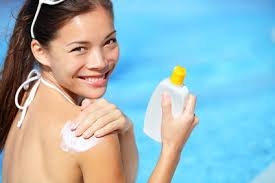Summer Skin Tips
The sun transmits two types of damaging UV (ultraviolet) light. UVA rays, which penetrate deeply into the skin to cause premature aging, and UVB rays, which reach just below the skinís surface and cause burning. Both UVA and UVB rays can cause skin cancer.
Do you know the limits of your sunscreen?
How to read a sunscreen label:
- SPF means Sun Protection Factor, which is the amount of time you can stay in the sun without burning (the higher the SPF number, the more protection offered).
- The Dermatology and Skin Cancer Center recommends SPF 30 or higher.
- Ultraviolet (UV) Rays: a form of visible light energy given off by the sun. There are three types: UVA and UVB, which are responsible for skin cancer and premature skin aging (wrinkles, lines and loss of elasticity), and UVC, which donít reach the Earth because the atmosphere filters UVC rays out.
- Water-resistant/waterproof/sweat-proof: These terms mean that a formula stays on the skin longer during a swim or long run. No sunscreen retains 100% of itís effectiveness after youíve gotten wet, or perspired, so be sure to reapply once you get out of the water or after exercising outdoors.
- Titanium Dioxide and Zinc Oxide: Made from natural minerals, these sunblocks are gentle, so they are the best choice for children and people with sensitive skin. They work by reflecting UV rays so they cannot penetrate the skin, and are therefore known as physical barrier sun protection. Chemical sunscreens, in contrast, absorb UV rays before they damage the skin (keep in mind that water is technically a chemical).
- Mexoryl SX: Most chemical sunscreens protect agains UVB rays only, but Meroxyl, along with oxybenzone and avobenzone (also called Parasol 1789) filters UVA rays, as well. These sunscreens are popular because they melt into skin and feel lightweight.
- PABA: Youíll often see the term: Paba-free on labels. This older chemical sunscreen is rarely used anymore because many people found it irritating to skin.
- UV rays are strongest between 10:00am and 4:00pm. If you are outside during these times, stay in the shade, under an umbrella, or wear a wide-brimmed hat (2-4 inch brim all around).
- A hat that is more than 4 inches wide can reduce head and neck exposure to UV light by 70%, according to the Skin Cancer Foundation. The best hats shield your ears and neck better so bucket hats are more effective than visors and baseball caps.
- Try UPF clothing that is treated with a special coating to help absorb UVB and UVA rays (the higher the UPF, the more it protects) Regular clothing can help protect you, too (darker colors of clothing provide more protection than white or lighter colors).
- Buy the correct sunglasses. Choose a pair that will block 99% of UV rays. Wider sunglasses will best protect the delicate skin around your eyes, and your eyes themselves, which is important, as UV exposure may contribute to cataracts and vision loss later in life).
 How to apply sunscreen:
How to apply sunscreen:
Apply a tablespoon of sunscreen to your face, neck and chest, use 2 tablespoons for your arms and about 3 tablespoons for your legs (a total of 6 tablespoons). Remember to also put sunscreen on the tips of your ears, lips, and the part of your hair and between your toes. Apply sunscreen before your makeup.
It takes about 20-30 minutes for sunscreen to be properly absorbed by the skin, so it wonít be effective until it sinks in. Apply sunscreen 30 minutes before you leave the house and reapply every hour if you are doing anything more than moderate exercise, even if your sunscreen is waterproof and regardless of the SPF. Reapply every 2 hours (regardless of activity level outdoors) to help protect your skin from sun damage and skin cancer.
Most of this information comes from an article from the Dermatology and Skin Cancer Center.

